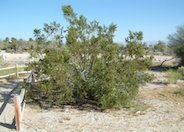
Common name:Creosote Bush
Botanical name:Larrea tridentata
Open, angular evergreen shrub grows to 6'x 6'. Dark green, foliage is fragrant after a rain. One of the most abundant plants in the southwest desert. Extremely drought tolerant. Good informal screen. Native to North American deserts.
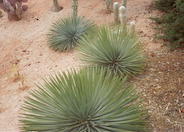
Common name:Our Lord's Candle
Botanical name:Yucca whipplei
Yucca grows to 3' x 6'. It has rigid, gray-green leaves. Its drooping, bell-shaped flowers appear on large, branched spikes 3-6' long. Plants die after blooming, much like agaves, but only individual rosettes will die off, others in in clump will continue to live and eventually bloom. Prefers well drained soil. Drought tolerant but will lose lower leaves with extended drought. Great accent plant. Native to California into Baja
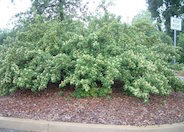
Common name:Red Clusterberry Cotoneaster
Botanical name:Cotoneaster lacteus
This is an evergreen shrub that grows to a size of 6-8' tall with long, arching branches. Cotoneaster exhibits dark green leaves above and gray beneath with dusky red fruit. It requires sun to part shade. Valuable for red berries and whitle flowers. This plant is tough enough to naturalize in many areas in CA, and should be considered potentially invasive.
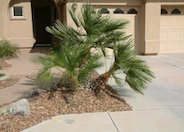
Common name:European or Mediterranean Fan Palm
Botanical name:Chamaerops humilis
Slow growing multitrunked palm good for small areas and containers. Full sun or partial shade. Leaves have sharp spines. Native to Mediterranean and Africa.

Common name:Live Oak
Botanical name:Quercus virginiana
Large evergreen tree growing to 40' x 50' at moderate rate. Dark green leaves are leathery and toothed. Flowers are nonshowy and appear in the spring. Accepts lawn conditions. Consider mature size. Accepts full sun. Native to the southeast U.S.
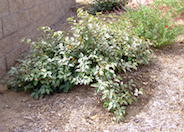
Common name:Fruitland Silverberry
Botanical name:Elaeagnus pungens
Evergreen shrub to 10-15' equally tall as wide. Through pruning you can keep it smaller. Large silvery leaves with rusty dots. Armed with spines. Good for hedge or dense barriers. Can be sheered; tolerates heat and wind. Tolerates bad soil.
| Designer: David A. Grant | Patio Garden LC 9 |
Photographer: GardenSoft |
Soils and Compost:
Incorporate compost 6" into your soil to retain water, reduce compaction, feed earthworms, and provide valuable nutrients to your plants.
Water Saving Tip:
Different areas of your landscape have different water requirements.
Shrubs need much less water than lawns and drip systems should never be scheduled on the same program with lawns.
Establish separate watering schedules for those areas.
Integrated Pest Management:
Remove irrigation water and fertilizer from areas where you don't want weeds to grow.
